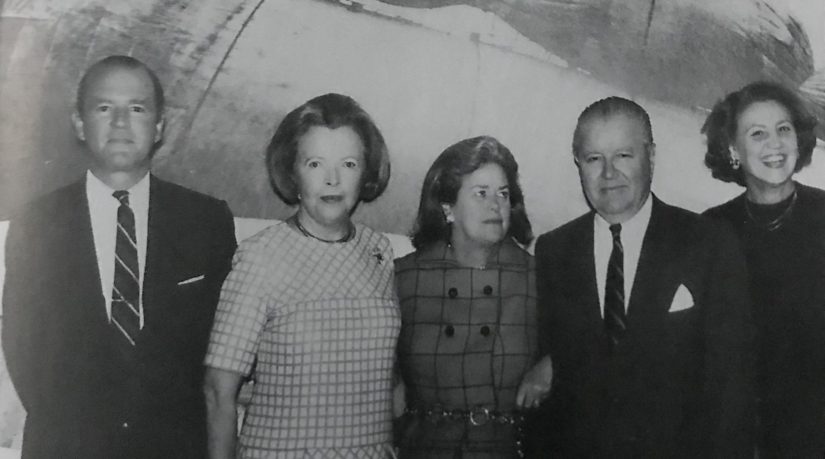
Ruth McAneny Loud
Ruth McAneny Loud served as the president of the Municipal Art Society from 1965-1970.
The daughter of leading civic figure George McAneny, Ruth McAneny was born in 1901 and grew up in Manhattan. She attended the Brearley School and then Bryn Mawr College, which she graduated in 1923. She married Henry Sherman Loud, Jr. the following year and the had two children, Roger and Margaret.
Loud taught at the Brearley School from 1929-1946, and through her associations there met Agnes Adams Wales, with whom she wrote New York! New York! A Knickerbocker Holiday For You and Your Children, published in 1946. She then served as Director of Development at the Museum of the City of New York. She joined the Municipal Art Society in 1954, becoming President in 1965. Though she was ousted as president in 1970, she continued to be on the board of MAS until her death, as well as serving as the steward of her father’s papers. Loud died on Dec. 31, 1990, at the age of 89.1
Museum of the City of New York
Director of Development
Municipal Art Society
President, 1965-1970
Ruth McAneny Loud joined the Municipal Art Society in 1954, a year after her father’s death. In her early years with the organization she supported the Municipal Art Society’s new and growing efforts at public outreach in the form of public exhibitions, talks, and walking tours. The 1950s was a period of transition for the Municipal Art Society – on the heels of significant preservation battles of the late 1940s and early 1950s, like the conflict between Robert Moses and preservationist groups over Castle Clinton and the demolition of the Rhinelander Houses, the Municipal Art Society became increasingly focused on advocacy for a preservation law and the establishment of what would become the Landmarks Preservation Commission. Major campaigns the Municipal Art Society undertook in the mid-late 1950s include the preservation of the Jefferson Market Courthouse, the push to close Washington Square Park to vehicular traffic, and the unsuccessful effort to prevent Penn Station from being demolished.
Alongside an increasingly formal legal strategy, the group also developed its public presence and outreach, most notably in the form of walking tours which the Municipal Art Society began hosting in 1956. The tours were largely researched and presented by member Henry Hope Reed, an architectural historian and advocate for the preservation of classical architecture, who became Central Park’s first curator in 1966.2 As Reed’s tours for the Municipal Art Society grew more popular, the Museum of the City of New York sponsored and promoted them, a connection that was made through Loud, who was Director of Development there at the time.3
With the establishment of the Landmarks Preservation Commission in 1965, the Municipal Art Society’s role and purpose changed; now MAS would need to balance its broader advocacy with a close working relationship with the Landmarks Preservation Commission – testifying at hearings, proposing landmarks, monitoring the legal process.4 That year, Whitney North Seymour, Jr., left the presidency after winning election to the state senate, and was succeeded by Ruth McAneny Loud, who became the first woman to serve as president.5 During her tenure, the Municipal Art Society successfully advocated for the establishment of the first historic district in the city, in Brooklyn Heights, offered its first slate of candidates for landmark status, and cosponsored an exhibition called “The Destruction of Lower Manhattan,” calling for the preservation of South Street Seaport, which was landmarked in 1977.6
Loud was ousted by a subgroup of members in 1970, who sought to professionalize the Municipal Art Society and democratize the process of choosing presidents and board members, having felt that the existing process was insular and clubby.7 She continued to serve on the board until her death.
- Municipal Art Society of New York Archive
- 488 Madison Avenue, Suite 1900
- New York, NY 10022
- Museum of the City of New York Annual Reports, 1927-2007
- Museum of the City of New York
- 1220 Fifth Avenue
- New York, NY 10029
- Tel: (212) 423-0758
- Oral histories with Bronson Binger, Charles Platt, and Whitney North Seymour, Jr.
- New York Preservation Archive Project
- 174 East 80th Street
- New York, NY 10075
- Tel: (212) 988-8379
- Email: info@nypap.org
- “Ruth McAneny Loud, Civic Leader, 89, Dies” New York Times, 2 January 1991.
- Bruce Weber, “Henry Hope Reed, Architectural Historian, is Dead at 97,” New York Times 2 May 2013, B17.
- Anthony C. Wood, Preserving New York: Winning the Right to Protect A City’s Landmarks (New York: Routledge, 2008), 152, 152n83.
- Gregory F. Gilmartin, Shaping the City: New York and the Municipal Art Society (New York: Clarkson N, Potter, Inc., 1995), 379; “Municipal Art Group Elects Mrs. Ruth Loud President,” New York Times, 24 November 1965, 32.
- Whitney North Seymour, Jr., Interviewed by Anthony C. Wood, 29 July 2006. https://www.nypap.org/oral-history/whitney-north-seymour-jr/ Accessed 1 October 2020; “Municipal Art Group Elects Mrs. Ruth Loud President,” New York Times, 24 November, 1965.
- “About Us: History” The Municipal Art Society. https://www.mas.org/about-us/history/. Accessed 30 September 2020.
- Gilmartin, 379-381.